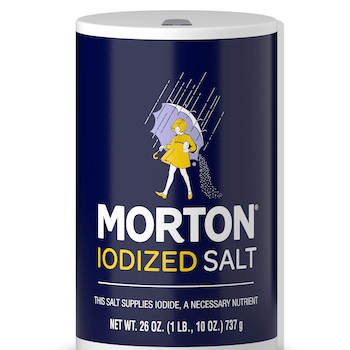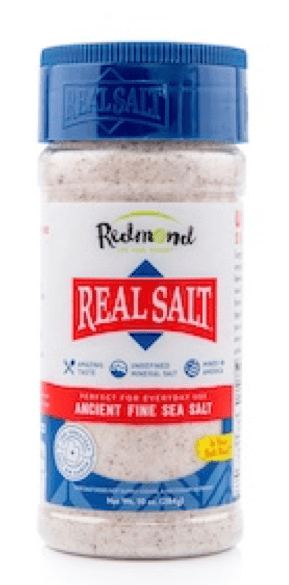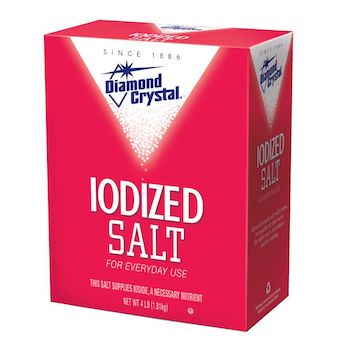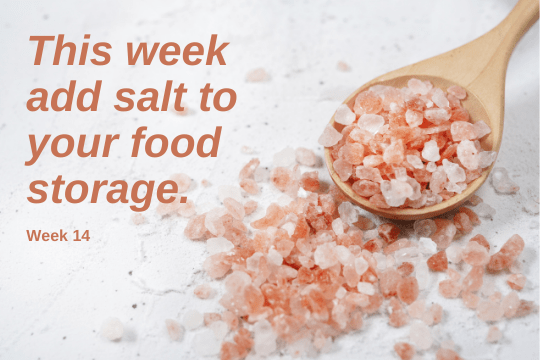Preparedness Challenge Week 14
Thanks for joining the 2022 Preparedness Challenge!
This week the challenge is to add salt to your food storage preparations. Salt is one of those basic commodities necessary for life that needs to be in every food storage plan. It is inexpensive and easy to store.
What Types of Salt Are Best for Storing?
There are many varieties of salt available today, but for practical storage there are three main types of salt that are readily available and ideal for storing: table salt, canning and pickling salt, and rock salt.
Table Salt

Table salt is used for normal cooking and eating. It typically contains calcium silicate, an anti-caking agent, to improve its pouring qualities. The label will state whether it is iodized or plain salt.
SALT WITH IODINE
Common table salt is often iodized to ensure that enough iodine is in the diet to avoid health problems associated with iodine deficiency. As salt ages, the iodine may produce a harmless, but unappetizing yellow discoloration. Iodized salt has a shelf life of about five years.
SALT WITHOUT ADDITIVES

Natural table salts without additives will last indefinitely if stored in a cool, dry location. Check the nutrition label to see if it contains any additional ingredients. Kosher salt, Redmond Real Salt, pink Himalayan salt, various sea salts, and other specialty salts are also suitable for storing, if desired.
KOSHER SALT

Kosher salt is pure salt with larger grains than table salt. It is about half as dense as table salt and even the two most common kosher salts, Morton and Diamond Crystal, vary in density. Chefs often prefer it for how its taste enhances food without bitterness. Kosher salt can be stored indefinitely.
SEA SALT

Sea salt may be made from evaporating ocean water or water from inland salt seas. Sea salt such as Redmond Real Salt is also harvested (see photo) in its natural state from deposits of ancient sea beds. Sea salts have unique minerals that give salt subtle flavor and color. It is less dense than table salt and does not have a bitter taste. Sea salt can also be stored indefinitely.
Pickling and Canning Salt
Pickling and canning salt is the purest of the salts and contains no iodine, additives, or anti-caking ingredients. If used for pickling and canning, it will not cloud the brine as table salt can. Kosher salt can be substituted for pickling salt, but it should be weighed for accurate measurements.
- 1 cup of picking salt equals 1½ cups of Kosher flaked salt (Diamond Crystal).
Rock Salt
Rock salt comes coarsely-crushed, in large pieces, or in blocks and is used to feed domestic animals, attract wildlife, preserve meats, tan hides, and make ice cream. It is generally not for human consumption, although specialty edible rock salt is used in salt mills.
How Much Salt Should You Store?
TABLE SALT
Begin with salt for table use. The Dietary Guidelines for Americans recommends that adults consume one teaspoon (2300 mg) or less of salt daily. There are about 75 teaspoons in a pound of salt, so five pounds of salt is about what a person needs for one year. Five pounds is a tiny bit more three 26-ounce canisters.
Keep it simple: Store five pounds of table salt per person.
This recommended amount is for a whole year. If you want something less, then a simple option is to store one 26-ounce canister per person.
Salt is inexpensive and easy to obtain, so give some consideration to storing more than might seem necessary in case of unforeseen situations.
OPTION 1
Purchase salt in 26-ounce canisters. These canisters are convenient with a pour spout and small enough to easily fit in a kitchen cupboard.
OPTION 2
Purchase five-pound bags of salt. Store the bags in a plastic container for easy handling and to prevent punctures. Keep salt for daily use next to your stove in a ceramic container.
OPTION 3
Purchase a twenty-five-pound bag of salt and store it in a plastic food-grade storage bucket.
STORE SALT FOR FOOD PRESERVATION
Store an additional five pounds of salt for all other purposes. Store some of this as pickling or canning salt and some as rock salt.
Tips for Storing Salt
Salt can be stored indefinitely, but it has several properties that require attention. Salt is hygroscopic and attracts and absorbs water. Because it is porous, it and can also absorb odors. Use these tips to assure a long shelf life:
- Store salt in a cool, dry environment.
- For simplicity and economy, purchase salt in bulk and store in sealed, plastic food-grade buckets.
- For convenience and more selection, purchase a variety of smaller containers of salt and store them in sealed, plastic food-grade buckets.
- In low humidity areas, salt can be left in its original cardboard or paper container, but paper packaging will eventually deteriorate.
- In high-humidity areas, place food-grade silica gel packets in salt containers.
- There is no need to use oxygen absorbers with salt.
- Store salt directly in glass containers with a tight-fitting lid.
- Store salt in ceramic or clay containers with tight fitting lids.
- Avoid using metal containers or lids because salt will corrode most metal.
Learn More

Find out more about storing foods in Crisis Preparedness Handbook, Third Edition (2020). If you don’t already have a copy, you can find it here on my website CrisisPreparedness.com. Or, read it on Amazon in the Kindle version or hard copy version.



2 thoughts on “Storing Salt in Your Food Storage”
I had no idea the variations available with salt. I can’t imagine life without it. It is definitely on my list of things to store.
Thanks for the details.
What fabulous ideas you have concerning this subject! By the way, check out my website at YH9 for content about Entrepreneurs.